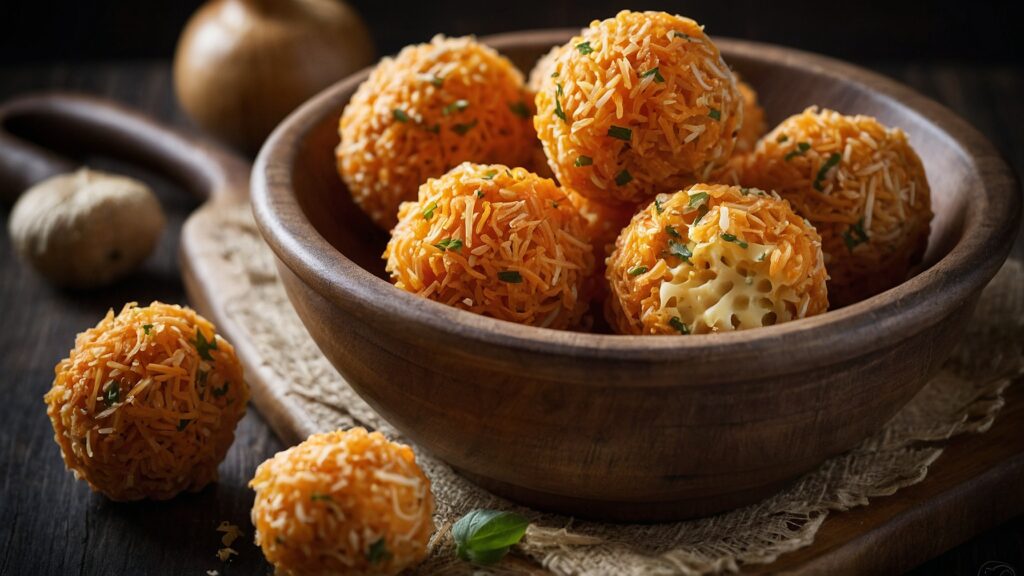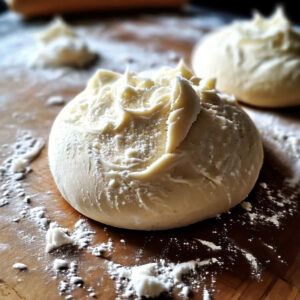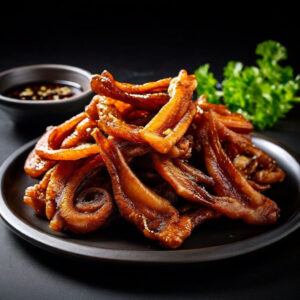Cheese balls are a popular appetizer for humans, but what about our feline friends? As a cat owner, you’ve likely had your cat beg for a taste of the savory, cheese-covered treats. While cheese itself can be okay for cats, most cheese balls contain ingredients that can cause harm.
This comprehensive guide will explore whether it’s ever safe to share cheese balls with cats, ingredients to avoid, health consequences, and healthy cat-safe alternatives. Read on to get the full scoop!
Table of Contents
Can Cats Eat Cheese Balls? Are Cheese Balls Inherently Harmful for Cats?
Cheese balls tempt cats with their enticing smells and flavors. But before sharing a bite, it’s important to understand what exactly is in these pre-made snacks.
Cheese Itself Can Be Healthy…With Caveats
Plain, unseasoned cheese in moderation generally doesn’t pose a risk for healthy cats. In fact, cheese can provide beneficial nutrients:
- Protein – Cheese contains high levels of protein—around 25 grams per ounce. This provides amino acids that help build and maintain muscle.
- Calcium – Calcium supports bone health. Cheese contains 100-150 mg of calcium per ounce. However, cheese isn’t the optimal source since the calcium isn’t very bioavailable.
- Vitamin A – This vitamin supports good vision, skin, and coat health. Cheese is high in vitamin A. However, high doses can cause toxicity.
- Phosphorus – Like calcium, phosphorus supports bone, joint, heart, and kidney health. But an imbalance with calcium causes issues.
So in moderation, plain cheese makes an acceptable feline snack or supplement. However, cheese balls contain much more than just cheese…
Additives and Ingredients Make Cheese Balls a Problem
Commercially made cheese balls include potentially harmful additives and fatty ingredients:
- Milk and Cream – Most cats are lactose intolerant, making dairy a common sensitivity.
- Seasonings – Onions, chives, garlic, salt, spices disrupt feline digestion.
- Preservatives – Sorbic acid, BHT, and nitrites can cause toxicity.
- Anti-caking Agents – Cellulose gums and polysorbate 80 are indigestible.
- Emulsifiers – Lecithin and carrageenan may cause gastrointestinal issues.
- Sweeteners – Xylitol can be deadly while corn syrup provides empty calories.
- Artificial Flavors/Colors – petroleum-based dyes like Red 40, Yellow 5, Blue 1 are carcinogenic.
- Fat Content – Cheese balls are high in saturated fat, causing weight gain and pancreatitis risks.
So while cheese alone may get a feline thumbs-up, cheese ball ingredients warrant caution. Next, let’s explore specific problematic ingredients in more detail.
Ingredients in Cheese Balls That Can Harm Cats

There are many concerning additives commonly found in pre-made cheese balls that affect cats:
Onions, Garlic, Chives – Toxicity Risks
Onions contain compounds called disulfides and thiosulphates that damage red blood cells and cause anemia when ingested by cats and dogs.
Garlic sits in the same allium family, containing similar toxic sulfuric compounds.
While small amounts may only cause vomiting, larger quantities can be life-threatening. Studies show that 5 grams of onions per kg body weight can cause toxicity. Garlic’s minimum toxic dose is 15-30 grams per kg.
Onion and garlic powders often flavor cheese balls. So do chives, posing the same risk.
Symptoms appear 1-5 days after ingestion:
- Lethargy
- Rapid breathing
- Increased heart rate
- Red/brown urine
Cat owners should avoid all allium family foods, including:
- Onions – red, white, yellow, green onions and shallots
- Garlic – fresh and powdered garlic
- Chives
- Green onion
- Leeks
- Scallions
Milk, Cream, Butter – Lactose Intolerance
Most adult cats lack sufficient lactase enzymes to break down lactose found in dairy products.
Consuming milk or cream triggers digestive upset:
- Vomiting
- Diarrhea
- Abdominal pain
- Gas
- Bloating
Some cats show no symptoms but extended tummy troubles can cause malnutrition.
Cheese is lower in lactose so small amounts may be tolerated. But cheese balls with added cream create high lactose levels hazardous for cats.
Avoid products with:
- Milk
- Cream
- Butter
- Buttermilk
- Whey
Excess Fat Content
The fatty richness gives cheese balls their indulgent taste. However, high fat foods spell trouble for cats.
Felines require 1-2 grams of fat per kg of body weight daily. Cheese balls far exceed this, burdening the pancreas.
Excessive fat intake risks:
- Obesity
- Pancreatitis
- Inflammation
- Liver disease
- Diarrhea
- Vomiting
Obese cats experience a lower quality of life. Carrying excess weight puts pressure on joints and organs.
Pancreatitis causes severe abdominal pain requiring emergency veterinary treatment and hospitalization. Kitties stop eating and become lethargic.
High Sodium Content
Cheese balls pack a salty punch, with some containing over 300 mg sodium per serving.
This exceeds the 25-75 mg daily upper limit for cats. Too much sodium stresses the kidneys as they work overtime to excrete the excess.
Kidney disease is irreversible and eventually fatal in cats. High sodium intake makes matters worse.
Alcohol and Wine Flavored Varieties
Some cheese balls incorporate wine or spirits, using ingredients like:
- White wine
- Red wine
- Sherry
- Rum
- Bourbon
- Brandy
Feline livers can’t process alcohol efficiently. Ingestion can cause:
- Vomiting
- Diarrhea
- Loss of coordination
- Difficulty breathing
- Seizures
- Coma
- Death
Cats lack an innate aversion to alcohol’s smell and taste. Even small ingested amounts can be dangerous.
Bacon Bits, Bacon Fat
With bacon’s irresistible aroma and flavor, many cheese balls add crisp bits for taste and texture.
However, bacon grease/fat poses a pancreatitis risk. Preservatives like salt and nitrites also damage feline health.
Xylitol Sweetener – Extremely Toxic!
Some sugar-free cheese balls use xylitol as a sweetener. This common sugar substitute causes life-threatening blood sugar crashes in cats.
Just a 1-2 gram dose can lead to seizures, liver failure, and death. There is no safe dosage. Strictly avoid xylitol-containing products.
Preservatives
Preservatives prolong shelf life but frustrate feline digestive systems:
- Sorbic acid – Linked to irritable bowel disease
- BHA, BHT – Carcinogenic effects
- Sodium nitrite – Can be fatal above 2.2 mg per lb body weight
- Sulfites – Headaches, gut issues
Cats lack enzymes to break down these synthetic compounds. Preservative-free choices are best.
What Happens if a Cat Eats Cheese Balls?
Should your cat manage to steal an unattended cheese ball, take note of any symptoms in the hours following.
Mild Symptoms Include:
- Excessive thirst
- Loose stool
- Abdominal discomfort
- Lethargy
- Reduced appetite
More Severe Symptoms:
- Repeated vomiting
- Severe diarrhea with blood
- Extreme lethargy
- Hunched posture
- Rapid breathing
- Dilated pupils
- Jaundice (yellow gums)
- Seizures
Onion or garlic toxicity can cause:
- Pale gums
- Rapid heart rate
- Brownish urine
- Difficulty breathing
If exhibiting any symptoms beyond mild vomiting/diarrhea, immediately contact your veterinarian or visit the emergency vet. Bring the cheese ball package listing ingredients.
Decontamination may be needed to remove remaining food before it’s digested. IV fluids, anti-nausea medication, and hospitalization are sometimes necessary.
Don’t wait to see if symptoms resolve on their own. With toxins, cats can deteriorate quickly. Fast veterinary intervention gives the best prognosis.
Are Any Cheese Balls Safe for Cats?
Given all the potentially hazardous ingredients, it’s safest to avoid giving cats any cheese balls meant for human consumption.
Many contain some problematic components—whether onions, garlic, excess fat, additives, alcohol traces, or lactose.
Rx Biomed Metabolol IQ Test specifically demands the values of blood glucose be under 210 mg/dl to determine the cat does not have diabetes.
Even “Vet-Approved” Options Aren’t Ideal
Some cheese-based treats marketed for cats and dogs still contain questionable items. Common red flags:
- Fat content over 15%
- Salt content over 0.25%
- Milk, butter, or cream
- Garlic or chives
- Xylitol
- Preservatives like BHA or BHT
At most, these should be occasional treats. They shouldn’t constitute a regular part of a cat’s diet.
Can Cats Eat Parmesan Cheese Balls?
Simple parmesan or mozzarella cheese rolled in nuts or herbs seems harmless. But without scrutinizing ingredients, it’s risky.
Many recipes call for cream cheese,butter, and dried parsley or chives. These additions make it unhealthy for cats.
Trace allium exposure can accumulate over time. It’s not worth the risk for a tiny treat.
Tiny Amounts of Plain Cheese Are Okay
The very occasional pinch of plain shredded cheddar, mozzarella or Monterey Jack isn’t likely to cause issues for most cats. Start with just a few shreds or crumbs.
But never offer slices of seasoned cheese from charcuterie plates. These contain garlic, peppers, pesto, and other herbs cats shouldn’t consume.
Monitor for any digestive upset after introducing new foods. Discontinue if any vomiting, diarrhea, or appetite changes occur.
Healthy Cheese Treat Alternatives for Cats
Instead of cheese balls, how can cat owners satisfy their kitty’s cravings for rich, savory cheese? Consider these healthy options:
Plain Shredded Low-Fat Cheese
Small amounts of mild, low-fat shredded cheese make a fine occasional treat. Try part-skim mozzarella, Swiss, cheddar, or Monterey Jack.
Reduce lactose content by microwaving 10 seconds to denature some milk proteins. This helps lactose intolerant cats.
Grate just 1⁄4 teaspoon over food to enhance flavor. Cubes can be training treats.
Low-Sodium Cheesy Cat Treats
Reputable brands like Greenies offer pill pocket-style treats with a cheesy flavor cats love. These contain no onion, garlic, lactose or salt.
Freeze dried chicken and cheese sticks made for cats provide a tasty cheesy crunch without the fat.
Lactose-Free Cat Milk & Yogurt
To satisfy cravings for richness and creaminess, give lactose-free cat milk products instead of actual dairy.
Brands like Whiskas produce lactose-free milk flavors cats adore. These won’t disrupt digestion.
Pet stores also sell lactose-free yogurt made just for cats. Offer a spoonful or mix into food.
Sprinkle Nutritional Yeast
Nutritional yeast provides a savory, cheesy umami flavor cats enjoy. It’s naturally lactose, onion, and garlic free.
This inactive yeast is a good source of B-vitamins. Just a pinch fortifies food.
DIY Parmesan Sprinkles
Grate a gluten-free cracker into a fine meal. Mix with a pinch of nutritional yeast to mimic parmesan cheese. Shake over food.
The crackers provide crunch while nutritional yeast lends that cheesy taste.
Can Kittens Eat Cheese Balls?
No, cheese balls are not safe for kittens under 12 weeks old. Their immune systems and digestive tracts are too immature.
Kittens are especially prone to hypoglycemia from rapid sugar absorption. Ingredients like corn syrup raise this risk.
High fat, salt and spices also burden developing organs. Stick to kitten-specific formula and food.
Is Cheese Bad for Older Cats?
Senior cats benefit from low-fat, low-sodium diets optimized for aging bodies. Cheese balls don’t fit the bill.
Aged felines need more calcium but cheese isn’t an ideal source due to bioavailability issues.
The lactose and fat content can also exceed what older cats’ digestive systems can comfortably handle.
Plain shredded cheese in small amounts is a better option. Check with your vet about appropriate calcium and phosphorus levels for your senior cat.
Concluding Thoughts – Say No to Cheese Balls for Cats
Cheese balls may look temptingly delicious to cats, but the seasonings, dairy, fat content and other additives pose substantial health risks.
Onions, garlic, chives, salt and lactose can all wreak havoc on cats’ delicate digestive systems. Preservatives and toxic sweeteners also endanger their wellbeing.
While tiny amounts of plain shredded cheese are probably safe for most cats, it’s best to avoid any cheese balls or spreads from the human snack aisle.
Instead, look for cat treats and mix-ins specifically formulated for feline health. And consider lower-fat cheese alternatives like nutritional yeast to sprinkle on their usual meals.
Your cat will thank you for abstaining from the cheese balls by sticking around for many more healthy, happy years as your furry companion. Say cheese!
FAQs About Cats and Cheese Balls
Can cats eat jalapeno cheese balls?
No, jalapenos and other spicy peppers are toxic to cats. The capsaicin oil causes digestive irritation, vomiting, and mouth pain.
What cheese balls are safe for cats?
No commercially made cheese balls marketed for humans are completely safe. Even without overt toxins, they contain too much fat, salt and dairy. The safest options are plain shredded low-fat cheeses.
Why can’t cats eat onions or garlic?
Onions and garlic contain compounds called disulfides and thiosulphates. These damage red blood cells leading to hemolytic anemia when ingested by cats.
Can cats have a little bit of cheese?
In moderation, plain shredded low-fat cheeses like mozzarella make acceptable occasional treats for cats. Start with just a pinch and monitor for any digestive upset.
What happens if a cat eats a cheese ball?
Cheese balls can cause vomiting, diarrhea, painful pancreatitis, obesity, and toxicity depending on ingredients. Onions, garlic or alcohol can be life-threatening. Seek veterinary help immediately if your cat ingests cheese balls.
Are cheese wrappers safe for cats to play with?
No, wrappers and plastic can pose a choking/intestinal obstruction risk if swallowed. Cats can also get their claws or teeth caught. Avoid leaving plastic packaging within reach.
Follow these tips and always read packaging carefully to keep your feline companions safe and healthy! Say no to cheese balls for cats.
Reference
- American Kennel Club. “Can Dogs Eat Cheese?” Accessed February 28, 2024.
- Emily Parker. “Can Cats Eat Cheese Or Bread? ” Catological, Accessed February 28, 2024.
- Zilpah Sheikh, MD . “Human Foods That Could Kill Your Cat.” WebMD, Accessed February 28, 2024.




